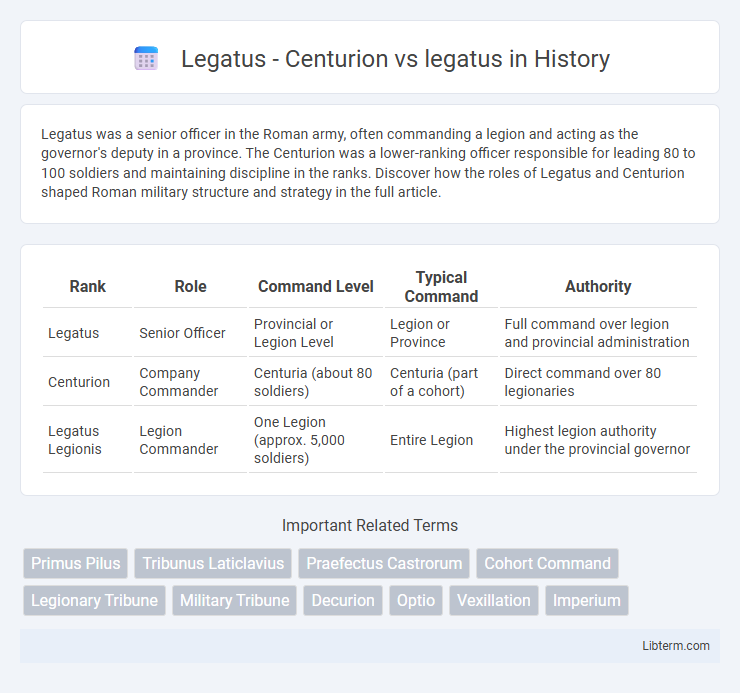Legatus was a senior officer in the Roman army, often commanding a legion and acting as the governor's deputy in a province. The Centurion was a lower-ranking officer responsible for leading 80 to 100 soldiers and maintaining discipline in the ranks. Discover how the roles of Legatus and Centurion shaped Roman military structure and strategy in the full article.
Table of Comparison
| Rank | Role | Command Level | Typical Command | Authority |
|---|---|---|---|---|
| Legatus | Senior Officer | Provincial or Legion Level | Legion or Province | Full command over legion and provincial administration |
| Centurion | Company Commander | Centuria (about 80 soldiers) | Centuria (part of a cohort) | Direct command over 80 legionaries |
| Legatus Legionis | Legion Commander | One Legion (approx. 5,000 soldiers) | Entire Legion | Highest legion authority under the provincial governor |
Introduction to Roman Military Hierarchy
The Legatus served as a senior officer commanding a Roman legion, typically appointed by the Senate or Emperor and holding overall strategic authority in military campaigns. In contrast, the Centurion was a mid-level officer responsible for leading a century, a unit of roughly 80 soldiers, and ensuring discipline and training within the ranks. This hierarchical structure positioned the Legatus at the apex of legion command, while Centurions functioned as crucial tactical leaders on the battlefield and within daily legion operations.
Who Was a Legatus?
A Legatus was a senior Roman military officer, typically serving as a legion commander or provincial governor, appointed directly by the emperor. Unlike a Centurion, who commanded a century (about 80 men) within a legion and focused on tactical leadership, the Legatus held broader strategic responsibilities, overseeing an entire legion of roughly 5,000 soldiers. The Legatus played a crucial role in implementing imperial policies and leading large-scale military operations during the Roman Republic and Empire.
The Role of a Centurion
A Centurion in the Roman army was a key officer responsible for commanding a century, roughly 80 legionaries, and enforcing discipline, training, and combat readiness. Unlike a Legatus who held higher strategic command over legions, the Centurion operated directly with soldiers during battles and daily routines, ensuring orders were executed on the ground. The Centurion's role combined leadership, tactical expertise, and frontline experience, making them indispensable to the Roman military structure.
Rank and Authority: Legatus vs Centurion
The Legatus held a higher rank and greater authority than a Centurion, serving as a senior officer commanding entire legions or provinces in the Roman army. A Centurion was a mid-level commander responsible for leading a century, typically consisting of 80 soldiers, and played a crucial role in battlefield tactics and maintaining discipline. While the Legatus had strategic command and political influence, the Centurion ensured execution of orders and direct leadership within the ranks.
Duties and Responsibilities
Legatus-Centurion served as a senior officer in the Roman army, commanding a legion of approximately 5,000 soldiers and responsible for overall operational strategy, discipline, and coordination during campaigns. The Legatus, often appointed directly by the emperor, held broader administrative authority including managing provincial governance and liaising with local leaders to maintain Roman order. While the Centurion focused on tactical leadership and the direct oversight of troops, ensuring battlefield effectiveness and training, the Legatus exercised strategic oversight and political duties essential to the legion's success and imperial control.
Selection and Career Path
The selection process for a legatus typically involves appointments by the Roman Senate or Emperor, emphasizing experience and loyalty, whereas a centurion is promoted through the ranks based on merit, valor, and battlefield performance. A legatus usually commands an entire legion or serves as a provincial governor, holding significant administrative and military authority, while a centurion leads a century of around 80 soldiers, focusing on tactical leadership and troop discipline. Career paths for legati often include political roles following military service, reflecting their elite status, whereas centurions may rise to higher non-commissioned officer positions but rarely reach senatorial ranks.
Impact on Roman Military Success
Centurions served as the backbone of the Roman legions, directly commanding groups of 80 soldiers and ensuring discipline, training, and tactical execution on the battlefield. Legati, as senior officers appointed by the emperor or Senate, coordinated multiple legions and implemented broader strategic objectives, bridging political intent with military operations. The complementary roles of centurions and legati were crucial for the Roman army's tactical adaptability and sustained campaigns, directly contributing to Rome's expansion and military dominance.
Distinctive Insignia and Dress
The Legatus insignia typically features a distinctive gold or silver eagle emblem prominently displayed on the cuirass or cloak, symbolizing supreme command over a legion, while the Centurion's insignia includes a transverse crest on their helmet and a vine staff (vitis) denoting authority within the century. Dress for the Legatus often includes more ornate armor and a purple-bordered cloak (paludamentum) indicating senatorial rank and command status, contrasting with the Centurion's practical segmented armor (lorica segmentata) and simpler tunic designed for battlefield leadership. The visual distinctions in insignia and attire emphasize the Legatus's strategic leadership role versus the Centurion's tactical command within the Roman army.
Famous Legati and Centurions in History
Legatus and centurion roles were crucial in Roman military hierarchy, with legati serving as high-ranking officers or provincial governors, exemplified by figures like Julius Caesar and Germanicus. Famous centurions such as Lucius Vorenus and Titus Pullo gained renown for their leadership in frontline combat and resilience. The distinction lies in legati commanding legions or regions, while centurions led centuries, reflecting a clear chain of command essential for Roman military success.
Legacy and Influence on Modern Military Structures
The Legatus held supreme command over a Roman legion, wielding significant strategic authority that shaped early military hierarchies. Centurions, commanding century units within legions, established enduring leadership models emphasizing discipline and tactical execution. These roles collectively influenced modern military structures by embedding hierarchical command, unit cohesion, and leadership principles within contemporary armed forces.
Legatus - Centurion Infographic

 libterm.com
libterm.com